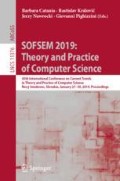Abstract
There have been many attempts to find directed graph classes with bounded directed path-width and bounded directed tree-width. Right now, the only known directed tree-width-/path-width-bounded graphs are cycle-free graphs with directed path-width and directed tree-width 0. In this paper, we introduce directed versions of cactus trees and pseudotrees and -forests and characterize them by at most three forbidden directed graph minors. Furthermore, we show that directed cactus trees and forests have a directed tree-width of at most 1 and directed pseudotrees and -forests even have a directed path-width of at most 1.
The work of the second author was supported by the German Research Association (DFG) grant GU 970/7-1.
Access this chapter
Tax calculation will be finalised at checkout
Purchases are for personal use only
Notes
- 1.
This means, in graph \(G'\) the edge e and its two incident vertices u and v are replaced by the vertex w and all other edges in G incident with u or v are adjacent with w in \(G'\).
- 2.
This means, in digraph \(G'\) the edge e and its two incident vertices u and v are replaced by the vertex w and all other edges in G incident with u or v are incident with w in \(G'\).
- 3.
This means, in digraph \(G'\) the cycle C is replaced by the vertex w and all other edges in G incident with a vertex in C are incident with w in \(G'\).
- 4.
A remarkable difference to the undirected tree-width [13] is that the sets \(W_r\) have to be disjoint and non-empty.
References
Bang-Jensen, J., Gutin, G. (eds.): Classes of Directed Graphs. SMM. Springer, Cham (2018). https://doi.org/10.1007/978-3-319-71840-8
Barát, J.: Directed pathwidth and monotonicity in digraph searching. Graphs Comb. 22, 161–172 (2006)
El-Mallah, E., Colbourn, C.J.: The complexity of some edge deletion problems. IEEE Trans. Circuits Syst. 35(3), 354–362 (1988)
Ganian, R., et al.: Are there any good digraph width measures? J. Comb. Theory Ser. B 116, 250–286 (2016)
Gurski, F., Rehs, C.: Computing directed path-width and directed tree-width of recursively defined digraphs. ACM Computing Research Repository, abs/1806.04457, p. 16 (2018)
Gurski, F., Rehs, C.: Directed path-width and directed tree-width of directed co-graphs. In: Wang, L., Zhu, D. (eds.) COCOON 2018. LNCS, vol. 10976, pp. 255–267. Springer, Cham (2018). https://doi.org/10.1007/978-3-319-94776-1_22
Harary, F., Uhlenbeck, G.E.: On the number of husimi trees: I. Proc. Nat. Acad. Sci. 39(4), 315–322 (1953)
Johnson, T., Robertson, N., Seymour, P.D., Thomas, R.: Directed tree-width. J. Comb. Theory Ser. B 82, 138–155 (2001)
Kintali, S., Zhang, Q.: Forbidden directed minors and directed pathwidth. Reseach report (2015)
Kintali, S., Zhang, Q.: Forbidden directed minors and Kelly-width. Theor. Comput. Sci. 662, 40–47 (2017)
Paten, B., et al.: Cactus graphs for genome comparisons. J. Comput. Biol. 18(3), 469–481 (2011)
Paten, B., Earl, D., Nguyen, N., Diekhans, M., Zerbino, D., Haussler, D.: Cactus: algorithms for genome multiple sequence alignment. Genome Res. 21(9), 1512–11528 (2011)
Robertson, N., Seymour, P.D.: Graph minors II. Algorithmic aspects of tree width. J. Algorithms 7, 309–322 (1986)
Scheffler, P.: Die baumweite von graphen als mass für die kompliziertheit algorithmischer probleme. Ph.D. thesis, Akademie der Wissenschaften in der DDR, Berlin (1989)
Author information
Authors and Affiliations
Corresponding author
Editor information
Editors and Affiliations
Rights and permissions
Copyright information
© 2019 Springer Nature Switzerland AG
About this paper
Cite this paper
Gurski, F., Rehs, C. (2019). Forbidden Directed Minors, Directed Path-Width and Directed Tree-Width of Tree-Like Digraphs. In: Catania, B., Královič, R., Nawrocki, J., Pighizzini, G. (eds) SOFSEM 2019: Theory and Practice of Computer Science. SOFSEM 2019. Lecture Notes in Computer Science(), vol 11376. Springer, Cham. https://doi.org/10.1007/978-3-030-10801-4_19
Download citation
DOI: https://doi.org/10.1007/978-3-030-10801-4_19
Published:
Publisher Name: Springer, Cham
Print ISBN: 978-3-030-10800-7
Online ISBN: 978-3-030-10801-4
eBook Packages: Computer ScienceComputer Science (R0)

